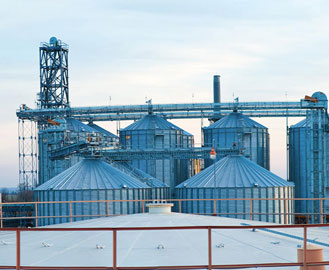-

- Bindicator
Food Industry
Application Detail
GRAINS
Grains are one of the key components and building blocks of many foods consumed by humans as well as animals and make up a significant portion of raw materials used in food production. Grain is not only essential to many different food production processes, it is also sold as a commodity, making it even more necessary to understand and maintain accurate inventory levels.
Both point level and continuous level measurement products can be effective in managing bulk inventory. Depending on the material and the requirements of the facility, a model can be chosen to best fit the entire manufacturing process.
- When determining high and low level points in a vessel, a point level switch is most effective.
- To have a constant stream of data regarding the level of material in a vessel, a continuous level sensor is most ideal.
- The ORB Inventory Management System will keep all data integrated and accessible to the appropriate people.
FOOD PROCESSING
Food processing encompasses a large segment of the overall food industry. Food processing made for human consumption has a multitude of regulations, as well as, strict requirements around accountability and reconciliation. Bulk inventory is often the first part of the process and is contained outside the facility, bringing in small batches as needed for specific parts of the manufacturing process.
Level sensors are most often used for bulk inventory management, but can also be used as back up to a weighing system
- For fail-safe systems, point level products can assist with avoiding spillage of an expensive ingredient or eliminate the opportunity of running out of an essential component.
- For the most accurate vessel data, the weight of the vessel can be determined using Kistler-Morse load stands or microcells.
PET FOOD
The production of pet food has become a $21 billion industry, whose growth has brought much attention to its associated processes. With more focus on the industry, manufactures are paying more attention to ingredient costs. As ingredients become more costly, it is more important to properly account for inventory. Bindicator level sensors provide that inventory management support.
Continuous level products by Bindicator can provide a constant level reading for materials in large vessels of bulk inventory. Level sensors can be used for monitoring the material and the Bindicator ORB Inventory Management System is used to capture and distribute that data to assist with other connected processes further down the line.
- One of the simplest, yet most reliable devices is the Yo-Yo
- Get the benefit of the more advanced technology of radar, while keeping in constant contact with the material with theTDR-2000
- For single or multi-tank applications that require more sensitive readings an ultrasonic unit may work best
- For the most advanced readings, radar options are avilable that can penetrate the most difficult environments
FEED MILLS
Feed mills manufacture feed for dairy, beef, horse and other live-stock animals. Ingredients used in animal feed include cereals, cereal by-products, proteins (from either vegetable or animals sources), co-products from human food manufacture, minerals, vitamins and feed additives. In order to keep production moving efficiently, it is imperative to maintain proper inventory levels of bulk materials.
Bindicator Point Level products provide a sense of security by informing you when a vessel requires filling or when it needs to be emptied. Point level products will alarm when material has reached a specific, predetermined point in the vessel.
Generally, the type of material and its bulk density in the vessel determines the best model choice.
- For lightweight, small, granule type materials, see the Roto-Bin-Dicator Paddlewheel Series
- For powders and materials with bulk densities of at least 3.15 lb/ft, see the Pulse Point II Vibratory Series
- For liquids/solid solutions, like salt brine, see the Pulse Point II Vibratory Series
- For materials that may be sticky of have a thicker resin type material, see VRF II Series


Copyright © 2020 Venture Measurement Co. LLC